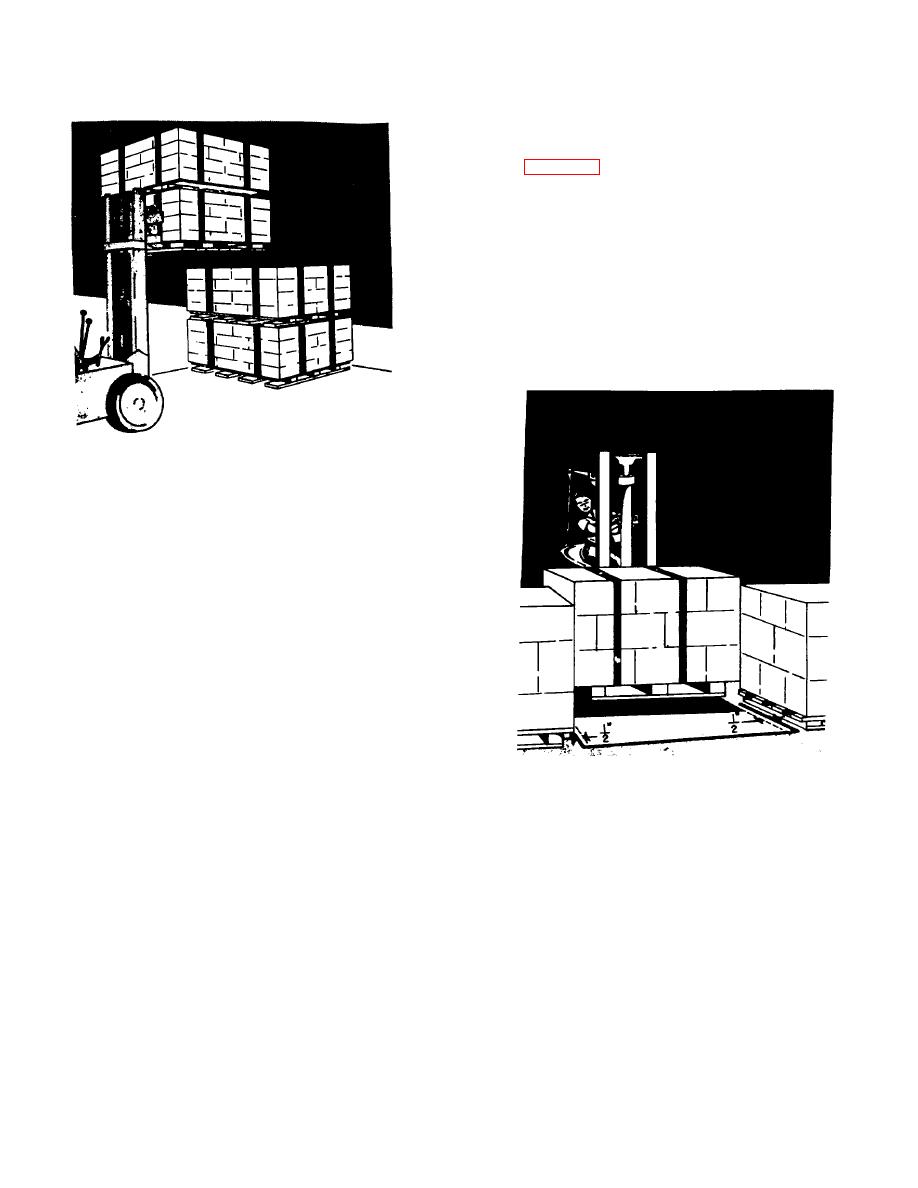 |
|||
|
|
|||
|
Page Title:
Figure 4-119. A double pallet load must be tiered with an overhang of no more than 2 inches in any direction. |
|
||
| ||||||||||
|
|
 TM 38-400/NAVSUP PUB 572/AFMAN 23-210 MCO 4450.14/DLAM 4145.12
This lesson is designed to teach placement and handling
of loads in limited spaces. The trainee should now be
ready to place a pallet load between two other pallet
loads with only 1/2-inch clearance on either side of the
load (fig 4-120). This is to be accomplished without
stopping the fork truck. For the first few attempts,
additional clearance may be provided. In the next
operation, the trainee makes a similar maneuver, except
that they turn off a 14foot warehouse aisle and into
another aisle which is not more than 4 inches wider than
the pallet load. Since the space is only an inch or two
wider than the pallet load, the truck's line of approach
must be at a right angle to the line of stack. Making this
turn from a 14-foot aisle requires considerable practice;
the trainee should completely master this maneuver
before going on to the next lesson.
Figure 4-119. A double pallet load must be tiered with
an overhang of no more than 2 inches in any direction.
(b) The next step pertains to the tiering
of a double pallet load adjacent to the stacks. This
should also be accomplished with one swing of the truck
and with an error of not more than 2 inches on any side.
In carrying double pallet loads, the truck is operated in
reverse so that the operator will have an unobstructed
view. A fork truck has the same speed in reverse
motion as it does in forward motion. At this point, the
trainee can be instructed in the proper method of
operating loaded fork trucks up and down ramps. A
loaded truck, moving in a forward direction, can
negotiate a slight downward grade (not to exceed 50)
safely when the mast is tilted back. However, a loaded
fork truck will be driven up in forward motion and down
in reverse motion on all ramps.
Figure 4-120. The trainee must be able to take a pallet
(3) Lesson three.
load between two other pallet loads with only 1/2-inch
This lesson is a continuation of the trainee's practice in
clearance on either side.
tiering pallet loads. In the previous lessons, there were
no turning radius restrictions for the beginner. To get
(5) Lesson five.
the feel of the truck and to accustom their eye to its
This lesson is a continuation of lesson four. The trainee
travel, the operator was allowed unlimited space for
is required to back through the space between two pallet
maneuvering. Now, however, warehouse aisles should
loads with only 1-inch clearance on either side of the
be simulated by the placement of pallet loads in two
load. It is a difficult maneuver and must be performed
straight lines. The two stacks should be placed to form
often in warehousing operations. The trainee must learn
an aisle 14 feet wide. The trainee should not be
that, as the fork truck is traveling backward, they must
instructed to do the same tiering done in the previous
give equal attention to both the rear of the machine and
lessons in this limited aisle space. As the trainee
to the pallet load, which are in opposite directions
progresses, the aisle width can be reduced to the width
normally used at the installation.
(4) Lesson four.
4-86
|
|
Privacy Statement - Press Release - Copyright Information. - Contact Us |